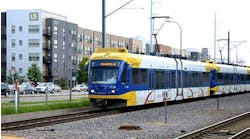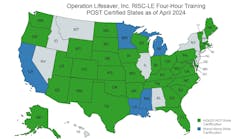More than $5.3 billion in private-capital transit-oriented development projects have been built, are under construction, or are planned near Dallas Area Rapid Transit’s light rail stations since the debut of DART Rail in 1996. Additionally, office properties located within 0.25 mile of a station command an average 13.9 percent higher lease rate.
The latest study from the Center for Economic Development and Research at the University of North Texas examines DART Rail’s positive impact on property development and extends the research to consider the effect on commercial lease rates.
“Even through difficult economic times, DART has demonstrated its ability to boost the North Texas economy through its daily operations, capital spending and attracting private investment,” said Terry L. Clower, Ph.D., director of the Center for Economic Development and Research at the University of North Texas.
Station areas outperform similar sites
Researchers evaluated developments located within 0.25 mile of a DART Rail station and found that the station area outperformed those in comparable control locations in each of five major property types. New developments built between 1993 and 2013 in close proximity to light rail totaled more than $1.5 billion in valuation, compared with roughly $600 million in control areas.
Of those completed projects, more than $751 million are multifamily residential developments; office developments total $224 million. Retail developments are worth $393 million, with Mockingbird Station and The Shops at Park Lane the most notable examples. Industrial and single-family properties also were more plentiful near rail stations.
“Although we are a young light rail system, transit agencies across the country are looking at our policies and practices to learn how we’ve attracted so much development to our station areas,” said Gary Thomas, DART president/executive director.
Beyond the property value, estimated tax contributions for development located near DART stations exceed $36 million annually, more than twice the $14 million estimated in the control group areas.
“The study analyzed the developments built near DART stations that were added to the tax rolls from 1993 to 2013,” Clower said. “But light rail access has revitalized downtown office buildings and attracted numerous civic, medical and other nonprofit properties as well.”
Billions in development underway
Developers have announced plans to build roughly $3.8 billion in projects deliberately located near DART Rail over the next decade. If completed, more than 8,500 multi-family units, as well as several million square feet of office and retail space, will arrive near DART stations. Estimates suggest these developments will contribute $91 million in annual real property tax revenues to local jurisdictions.
In the period since the UNT center’s 2007 study of similar data, several planned projects have changed considerably or been removed from discussion, while new ones have emerged. The estimate of $3.8 billion in DART-attributable investment is a moving target, and researchers intend to update the figure as more information becomes available or new projects are announced.
“Development around DART Rail stations is accelerating due to the build-out of the rail system and economic recovery,” Clower said.
Nearly all major projects under construction or planned near DART Rail stations have some residential component. According to the research, multi-family and office property developments are especially suited to station areas, which is consistent with transit-oriented and new urbanism-style developments.
Premium on Office Lease Rates
The UNT center also documented that offices located within the quarter-mile radius of DART Rail stations command an average 13.9 percent higher rental rate than comparable properties with highway-only access. Utilizing data from the Xceligent, Inc.,® real estate market database, researchers looked at stations that opened between 1996 and 2002 – through the Garland, Richardson, and Plano extensions – and found the premium held through the recession and recovery periods of 2008-2012.
“The positive impact of DART Rail on office construction and lease rates is directly correlated to tenant demand for walkable developments and transit options,” said DART Chief Financial Officer David Leininger. “Proximity to DART is a marketing advantage for recruiting talent.”


